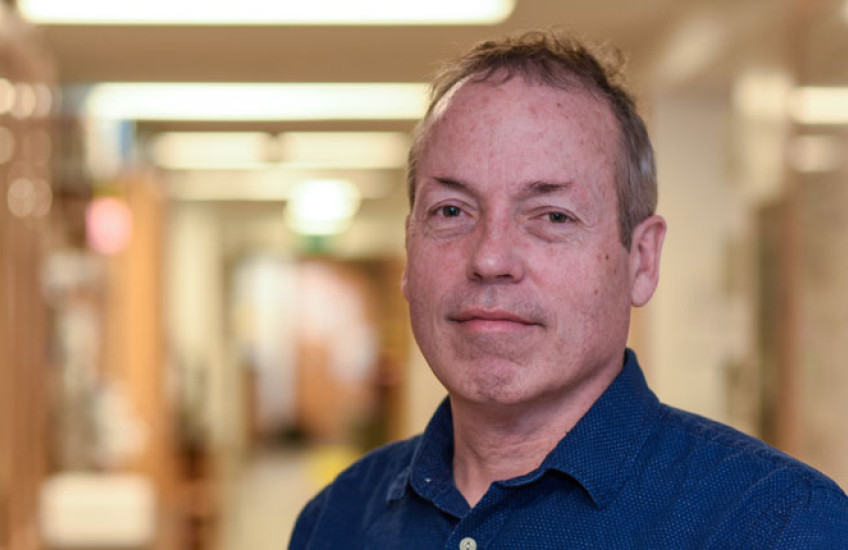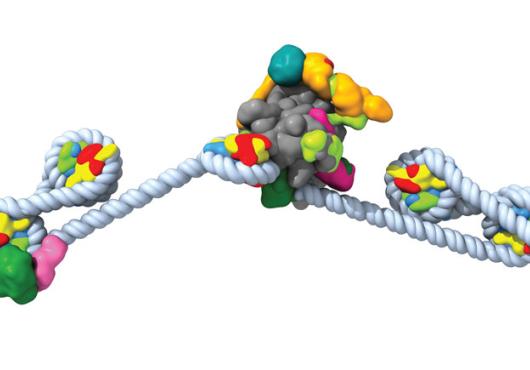As the leader of a busy research lab devoted to studying the sense of touch, becoming chair of the Department of Neurobiology was not part of David Ginty’s initial plans.
However, after nearly a decade at HMS, Ginty has gained deep knowledge about the ins and outs of the department and the School while forging close connections and collaborations with many of his fellow faculty. So when chair Michael Greenberg, the HMS Nathan Marsh Pusey Professor of Neurobiology and Ginty’s former postdoctoral advisor, decided to step down to focus more fully on his research, Ginty stepped up.
“It’s an exciting time for the field of neuroscience, and the neurobiology department at HMS is poised to make considerable advances in the coming years,” Ginty said. “Having been here for a long time, I thought I was in a good position to help move the department forward into the future.”
In a conversation with Harvard Medicine News, Ginty, the Edward R. and Anne G. Lefler Professor of Neurobiology in the Blavatnik Institute at HMS, shared his vision for the neurobiology department.
Harvard Medicine News: Why is this such an exciting time in the field of neuroscience?
Ginty: To start with some history, neurobiology as a discipline has its roots here at HMS, starting in the 1950s and 1960s. Stephen Kuffler, our founding chair, established the department in 1966. It was the first neurobiology department in the country. The idea at that time was that this new discipline would bring together scientists with expertise and interest in different areas — physiology, anatomy, microscopy, cell biology — to study the organ system that makes us who we are: the nervous system and the brain. That was a really visionary step in the biomedical sciences.
Today, as we develop new, more complex technologies to study neuroscience, we have a convergence of approaches that is making the field even more compelling than it was in 1966. We are using advanced methods in physiology, imaging, molecular biology, and microscopy to study how genes and neuron types shape nervous system function, connections between nerve cells in the nervous system, and underlying developmental mechanisms.
We have new techniques such as optogenetics and chemogenetics that allow us to manipulate neurons using light and chemicals. Computational approaches, which are becoming an increasingly integral part of our research, enable us to analyze large datasets and study the brain in many new ways. Much of the technology is being developed in our department and across the University.
Science. Medicine. Humanity.
Harvard Medicine magazine delivered to your inbox
These new advances are reaching a point where I think we will have a breathtaking array of discoveries in neuroscience in the next 10 to 20 years. We now have an opportunity to address age-old questions about how the brain functions, how it develops, and what goes wrong in disease.
The sky’s the limit! However, we will only be able to reach our potential if we have enough core scientific infrastructure and collaboration, which I will focus on in my new role.
HMNews: Can you expand on why core scientific infrastructure and collaboration are so important?
Ginty: With all of these remarkable advances, a key question for us as a department is how individual laboratories can make use of them. Many of these technologies are sophisticated, costly, and require personnel above and beyond what an individual laboratory can house or support — and each approach, whether computational, molecular, cellular, or genetic, requires narrow and deep expertise. Moreover, some of the most compelling questions in our field require a convergence of these approaches.
To me, what’s really essential for success in brain sciences, and certainly for the success of our faculty and department, is having core scientific infrastructure that allows laboratories to capitalize on the recent technical advances without having to develop them.
I’m especially interested in developing our instrumentation capabilities, which include microscopy, functional connectomics, and instrumentation and machine shop cores. The success of each lab in our department is increasingly reliant on these cores, so we need to enhance support for them and their capabilities.
For example, with the technological advances in neurophysiology and imaging over the last few years, we can now simultaneously measure the activity of dozens, hundreds, even thousands of neurons across broad brain areas in living animals, enabling us to understand the language of the nervous system.
However, such research requires serious instrumentation, including complex recording electrodes, advanced imaging technologies, and computational approaches to analyze huge amounts of data. I’m excited about expanding our core capacity so that we can do more of this kind of work.
We also need collaboration between laboratories so that our scientists can bring their different expertise together to advance the science beyond what any individual laboratory can do. I plan to develop better ways to enable collaboration, assign credit for collaborative efforts, and provide core infrastructure for ambitious, cooperative research projects.
HMNews: Are there specific research areas you’d like to develop?
Ginty: One area is computational neuroscience. Many of the advances over the last 10 to 20 years have been in generating large-scale datasets. That’s true for molecular neuroscience, which includes DNA sequencing, single-cell sequencing, transcriptomic approaches, and molecular insights into disease states, as well as for systems-level neuroscience where people are looking at the activity of thousands or tens of thousands of neurons simultaneously to understand the encoding of neural information.
Large datasets are now a part of everything we do, which means that, as a discipline, we are increasingly reliant on computational approaches to interpret neuroscience data. Yet, while some individuals and laboratories are well versed in computational approaches, others are not, even though everybody needs it.
My vision includes strengthening our computational capabilities, both within the department and through collaborations with the Harvard Faculty of Arts and Sciences and the newly formed Kempner Institute for the Study of Artificial and Natural Intelligence.
I’ll also strive to develop the area of connectomics, which involves comprehensively understanding the connections between neurons in the brain, and connections between the brain and body.
Currently, doing connectomics research is challenging: It’s slow and labor intensive. However, here at Harvard we have world leaders in this area, and I think that in the next 10 to 20 years, connectomics technology will advance to the point where we can gather data much more quickly and easily.
With this capability, neuroscientists will be able to study how connections in the nervous system develop over time, how they differ across organisms, what happens to the brain’s connections as an animal learns a new task, and how the connections in the brain change in disease states.
I think that we, as a department, as a university, and as a field, will benefit by investing in connectomics because it is relevant and powerfully useful for addressing the questions that most, if not all, of us are asking or hope to ask.
HMNews: Thinking beyond research, what are your goals for training the next generation of neuroscientists?
Ginty: We are incredibly blessed to have a tremendous graduate program in neuroscience, which is ranked as the top neuroscience graduate program in the world. Our students are the glue that holds us together — they‘re the engine that drives the science, innovation, and collaborations between laboratories within the department and throughout the University.
Working with our graduate students is arguably one of the greatest things about being a faculty member at Harvard, so we are heavily invested in making the neuroscience graduate program as good as it can be by providing the most and the best research and training opportunities.
It’s a bit of a moving target, because we need to invest in teaching the latest technical and conceptual approaches in neuroscience — for example, right now, we need to increase our ability to train students in computational neuroscience. As chair, I am committed to recruiting and retaining the top students and training them with the most modern approaches for neuroscience and collaborative science.
It’s important to remember that our graduate program is an interdepartmental graduate program, meaning students don‘t just work in the neurobiology department, but they also work at the Harvard Center for Brain Sciences, the Faculty of Arts and Sciences, and HMS-affiliated hospitals and institutions.
Our students engage in the entire Harvard neuroscience ecosystem, and they mediate ties between neuroscience labs across the University and affiliates. In this regard, we have some exciting new opportunities coming up. The Kempner Institute is a huge opportunity for Harvard and for scientists studying artificial intelligence and computational neuroscience.
The graduate program in neuroscience and the entire Harvard neuroscience community are going to benefit immensely from interactions with the Kempner. We’re especially excited to partner with the Kempner to advance computational training in the graduate program.
The postdocs in our department are amazing as well, and I think that this group includes some of the most talented neuroscientists in the world. A huge consideration for me is that we are facing a financial challenge for our postdocs, who don’t make as much in academia as they would in other industries.
Boston is an incredibly expensive city to live in, and frankly, our postdocs need to make more money in order to survive. One consequence of this challenge is that a majority of PhD graduates are now choosing career trajectories outside of academic science.
I think it is fine, and in fact necessary, that students and postdocs take advantage of amazing, emerging opportunities in biotech, pharma, venture capital, science investing, consulting, patent law, and data science. However, I don’t want postdocs who would be inclined to pursue academic science careers to choose otherwise for purely financial reasons.
I’ve had the most incredible career in academia, and it’s hard for me to imagine having done anything else with my life. I want our students and postdocs to have that opportunity, if academic research is their passion. We need to better support our trainees financially in order for academic science to be a viable career option. There’s no simple solution, but it’s something I have given a lot of thought to, and will keep thinking about as chair.
HMNews: What do you love about being a researcher at HMS?
Ginty: The people here are exceptional. The faculty and staff, the graduate students and postdocs, and the undergraduates that work with us are brilliant, ambitious, talented people. That’s the kind of person who wants to be at HMS. There’s a fantastic talent pool here, and I am in awe of this amazing group of people.
Also, the sheer number of laboratories at HMS and across the University and affiliated hospitals is staggering. There are hundreds of laboratories affiliated with HMS, and thousands more if you include other local universities and hospitals. There are also numerous connections between academia and industry — the biomedical research ecosystem in Boston is second to none.
What that means is that if you are collaborative and resourceful as a scientist, you can do anything here. It’s the perfect convergence for functioning as a scientist at the absolute highest level, and I consider myself incredibly fortunate to be in this position.
HMNews: How do you plan to build on what Michael Greenberg accomplished as chair?
Ginty: Mike was the longest-tenured chair of this department, serving for more than 14 years. What he did to advance this department and the field is unparalleled. He hired superstar junior faculty who have made huge advances in the field, but more than that, he set the tone for a tremendous amount of collegiality and collaboration in the department. That’s trickled down to influence how the faculty and trainees interact and treat one another. He really made our department a family.
I think that if you’re happy with where you work and you work well together, it’s going to pay off in terms of collaboration and research, which advances the science and training. Mike also set a really high bar scientifically: his own lab leads the world in the area of molecular neuroscience and genetic control of neural function. He’s led by example in terms of what one can and should be able to accomplish in a tremendously rich scientific environment like ours.
One lesson I’ve learned from Mike is that it’s really all about building a community of support where we help each other, we collaborate with each other, and we’re generous with each other. I do believe that this is the preeminent neurobiology department in the world with the best neuroscience training program in the world, and we can thank Mike for that.
He had just the right formula for making that happen, and he’s been tireless and incredibly talented at building community and working behind the scenes to create infrastructure. Mike is beloved. He’s honest and he tells it like it is, and people feel that they can trust him and rely on him for support. Mike left enormous shoes to fill, and I only hope that I can continue his legacy.
This interview was edited for length and clarity.









